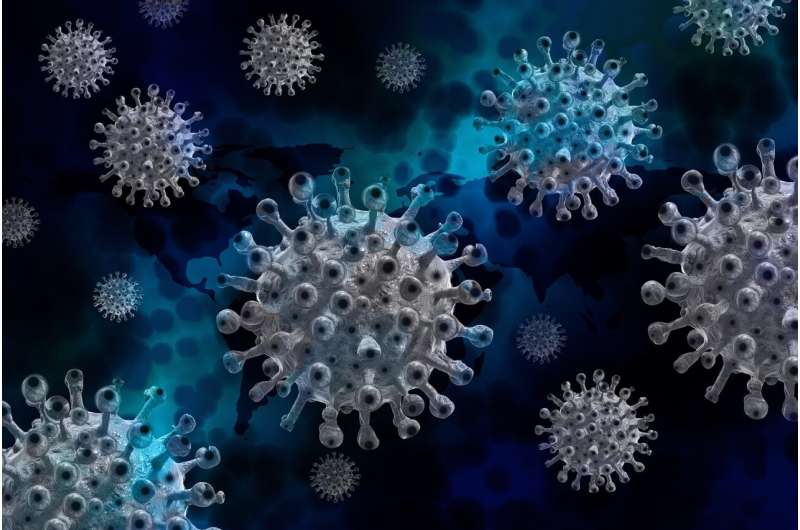Researchers unravel omicron's secrets to better understand COVID-19

When South African scientists announced in November that they had identified a new variant of the virus that causes COVID-19, they also reported two worrying details: one, that this new variant's genome was strikingly different from that of any previous variant, containing dozens of mutations compared with the original virus that emerged in 2019; and two, that the new variant—dubbed omicron—was spreading like wildfire.
The world needed to know quickly how well COVID-19 immunity—either from vaccination or prior infection—and therapies would hold up against this new variant.
Researchers at Washington University School of Medicine in St. Louis, led by Michael S. Diamond, MD, Ph.D., the Herbert S. Gasser Professor of Medicine, immediately started investigating the new variant of SARS-CoV-2, the virus that causes COVID-19. Within a few weeks, they had data showing that omicron was a mixed bag: It could resist most antibody-based therapeutics, but it was less able to cause severe lung disease, at least in mice and hamsters.
"What omicron demonstrates is that a virus's intrinsic pathogenicity—its ability to cause disease—is just one factor you have to consider in the context of a pandemic," said Diamond, also a professor of molecular microbiology and of pathology & immunology. "The omicron variant is less pathogenic, but it's not not pathogenic. It can still cause severe disease, and it still kills people. When you have huge numbers of people getting infected in a short period of time, even if only a small fraction get seriously ill, it can still be enough to overwhelm the health-care system. Add that to the fact that many of our antibody therapies have lost effectiveness, and you get the crisis we've seen this winter."
Diamond worked with Jacco Boon, Ph.D., an associate professor of medicine, of molecular microbiology, and of pathology & immunology, and colleagues at the SARS-CoV-2 Assessment of Viral Evolution (SAVE) Program to investigate omicron's capacity to cause severe disease. The SAVE Program was established by the National Institute of Allergy and Infectious Diseases to rapidly characterize emerging variants and monitor their potential impact on COVID-19 vaccines, therapeutics and diagnostics.
The omicron wave peaked first in South Africa. Early reports from the country indicated that the huge wave of infections was followed by a surprisingly small wave of hospitalizations and deaths. This encouraging news suggested that omicron might cause milder disease than previous variants. But the South African and U.S. populations are very different. South Africa is much younger, and has a lower vaccination rate but a higher rate of prior infection, and a different pattern of high-risk health conditions. It was unclear whether the U.S. would follow the same path as South Africa.
To separate the role of the virus itself from population factors such as average age and pre-existing immunity, Boon, Diamond and colleagues studied animals infected with the variant. The group tested omicron variants from three people in four strains of mice and two strains of hamsters. For comparison, they infected separate groups of animals with the original strain of SARS-CoV-2 or the beta variant, which emerged in South Africa in fall 2020. Beta caused a large wave of infections in South Africa in 2020 before spreading globally. People infected with beta were more likely to become severely ill and require hospitalization than those infected with other variants.
Compared with animals infected with the original strain or with the beta variant, animals infected with omicron lost less weight, had less virus in their noses and lungs, had lower levels of inflammation, and lost less respiratory function.
"Omicron virus is milder in every rodent model of COVID-19 disease that we tested," Boon said. "This suggests that it may also be less capable of causing severe disease in people, although we can't say for certain because people, obviously, are very different from mice and hamsters. But just because it might be milder doesn't mean it's harmless. People are still being hospitalized and dying every day, so it's important to continue taking precautions against infection."
The disease-severity study was published in Nature, with co-corresponding authors Boon, Diamond and Yoshihiro Kawaoka, DVM, Ph.D., a professor of virology at the University of Wisconsin-Madison.
Meanwhile, Diamond also began investigating omicron's ability to resist antibody-based therapeutics. The virus that causes COVID-19 uses its spike protein to get inside cells. Because of the critical importance of spike to the virus, all COVID-19 vaccines and antibody-based therapies used in the U.S. target the protein. Omicron has 30 mutations in its spike gene, enough to make scientists worry that some anti-spike antibodies might fail against omicron's very different spike protein.
Diamond, along with staff scientist and first author Laura VanBlargan, Ph.D., and colleagues tested all antibodies then authorized by the Food and Drug Administration to treat or prevent COVID-19—including antibodies made by AstraZeneca, Celltrion, Eli Lilly, Regeneron and Vir Biotechnology—for their ability to prevent the omicron variant from infecting cells. The antibodies were tested individually and in the combinations they were authorized to be used.
Most of the antibodies were much less potent against omicron than against the original virus. Many failed completely. Only Vir's antibody, known as sotrovimab, retained the power to neutralize the omicron variant. These data, published in Nature Medicine in January, contributed to a growing stack of evidence that many antibody-based COVID-19 therapies fail to help people sick with omicron. As omicron became the dominant variant in January, accounting for nearly all COVID-19 cases in the U.S., the FDA withdrew authorization for all antibody-based COVID-19 therapeutics except sotrovimab.
More information: Peter J. Halfmann et al, SARS-CoV-2 Omicron virus causes attenuated disease in mice and hamsters, Nature (2022). DOI: 10.1038/s41586-022-04441-6
Laura A. VanBlargan et al, An infectious SARS-CoV-2 B.1.1.529 Omicron virus escapes neutralization by therapeutic monoclonal antibodies, Nature Medicine (2022). DOI: 10.1038/s41591-021-01678-y


















